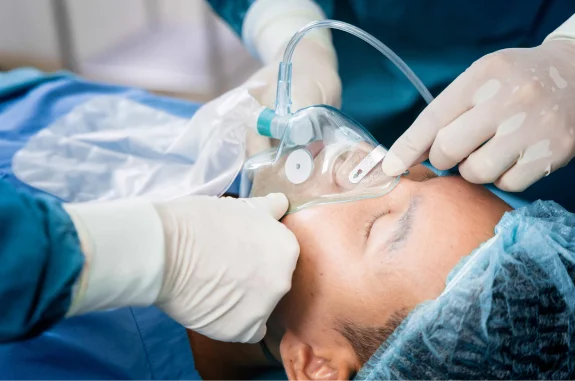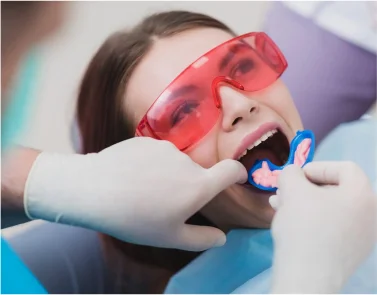Sleep Apnea: Wake Up Tired? Snoring? You Might Be Affected.
Sleep apnea is more than just snoring; it’s a condition where your breathing repeatedly stops and starts during sleep, often without you even realising it. These pauses can last for several seconds and happen hundreds of times per night, preventing deep, restful sleep.
The most common form is obstructive sleep apnea (OSA), which occurs when soft tissues in the throat collapse and block airflow. Another form, central sleep apnea, happens when the brain fails to send signals to the muscles that control breathing.
If untreated, sleep apnea can lead to fatigue, headaches, poor concentration, and even heart problems. That’s why timely dental sleep apnea therapy at Eagle Falls Dentistry is essential for better health and improved quality of life.


Should you see a sleep apnea doctor in Bloomingdale? Watch out for these common signs of sleep apnea:
If these symptoms sound familiar, schedule your sleep consultation today — early sleep-disordered breathing dentistry can help you regain control of your nights and days.
Choosing the right clinic for sleep apnea treatment, Bloomingdale patients trust, makes all the difference. Here’s why our patients rely on us:
Take the next step in advancing your dental health

Understanding the types of sleep apnea helps you know what’s happening during your sleep and what solution fits best:
| Type | Cause | Common Symptoms | Typical Treatment |
|---|---|---|---|
| Obstructive Sleep Apnea (OSA) | Airway blockage due to relaxed throat muscles | Snoring, gasping, tiredness | Oral appliance, CPAP, or surgery |
| Central Sleep Apnea (CSA) | Brain fails to send breathing signals | Shortness of breath, insomnia | Neurological therapy, medication |
| Complex Sleep Apnea | Combination of OSA and CSA | Persistent symptoms after CPAP use | Mixed treatment including dental therapy |
Most patients in Bloomingdale experience obstructive sleep apnea, which can be effectively managed with our dental sleep apnea therapy.
Wondering how sleep apnea near Bloomingdale is treated at our clinic? Here’s what to expect:
We discuss your symptoms, medical history, and perform an airway assessment to identify your sleep apnea type.
You may undergo a sleep test (either at home or through a partner lab) to confirm diagnosis and severity.
Based on your results, we recommend a personalized solution, often an oral device for dental sleep apnea therapy.
We take digital impressions and craft a custom-fit mouthpiece that gently repositions your jaw for easier breathing.
In advanced cases, a sleep apnea implant may be suggested to stimulate muscles and prevent airway collapse.
We schedule regular visits to monitor your sleep quality and make necessary adjustments for maximum comfort.

Regular exams allow dentists to monitor oral health, detect early signs of issues like cavities or gum disease, and provide timely interventions to prevent further complications

Deep cleanings remove plaque, tartar, and bacteria that daily brushing may miss. This helps prevent gum disease, tooth decay, and bad breath, keeping teeth and gums healthy

Fluoride strengthens tooth enamel, making it more resistant to decay. Applied during checkups, these treatments help prevent cavities, especially in children or those prone to decay.

Deep cleanings remove plaque, tartar, and bacteria that daily brushing may miss. This helps prevent gum disease, tooth decay, and bad breath, keeping teeth and gums healthy
Hate waiting weeks for your device? Ask about our same-day dental sleep apnea therapy. Using advanced digital scanning and in-house technology, we can fabricate your oral appliance faster, so you can start sleeping better within days, not weeks.
No bulky machines, no surgery, just comfortable, efficient care that fits your lifestyle.

Explore our gallery to see the stunning transformations and exceptional results we’ve achieved for our patients. Each smile tells a story of care and excellence

When expanded, each benefit includes insights on long-term health improvements and patient comfort.

D.D.S

D.M.D

D.M.D

D.M.D
Sleep apnea often occurs due to relaxed throat muscles, obesity, large tonsils, or airway obstruction. It can also result from neurological factors in central sleep apnea.
There are three types of sleep apnea: obstructive, central, and complex. Obstructive is the most common and is usually treated with oral appliance therapy.
Unlike bulky CPAP machines, oral appliances are small, quiet, and comfortable, repositioning your jaw to keep the airway open naturally.
Yes. Untreated sleep apnea can increase the risk of heart problems, diabetes, and chronic fatigue.
A sleep apnea implant is only recommended for severe cases or when other treatments fail. Your dentist will guide you through the best option.
Yes, especially if they snore frequently or have enlarged tonsils. Early evaluation helps prevent long-term issues.
Most patients feel better within days of using their oral appliance. Full benefits appear after consistent use.
Many insurance plans offer partial or full coverage. We’ll help verify your benefits before starting treatment.